With this year being poor for opportunity and excess, I ended up buying 2 cords of 'Green'.
I've been researching methods of expediting the drying process and found a few interesting ideas/ processes.
I also see it's bee talked about before here, but I don't see any listed results.
So, if you have done something on these lines, I'd love to hear what you've done and how well (or not) it worked.
I have 3 experiments running in the yard (ya, I'm serious about expediting drying) right now to see what works or doesn't.
The readings I will state are at full sun and ambient temp in the mid 60'sF
First is the 'Big Black Box'.
I took an old set of pipe staging and an old ladder (for shelves) and created a black plastic box.
The wood is stacked front and rear full, with the middle being open for air movement.
The ends of the middle was also stacked to create what I hoped to be a chimney.
Using 2 of my little solar panels and a computer fan, I set that up in the center to move air.
Since there is no vent at the top, I felt the fan is a must.
I have since added a second sheet of clear plastic, slopped off the unit to create more heat.
Unit reaches 98F in full sun inside.
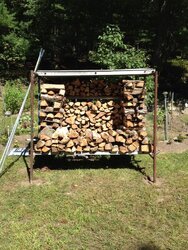
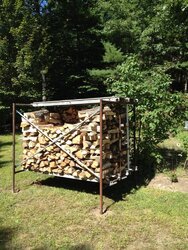
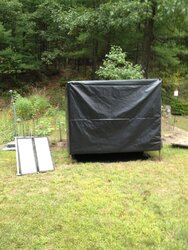
Second is the least expensive for 'anyone' to do and has been named the S&G Stack.
I thought.. Why not..
This is based on the lean-to cover.
I have since closed the front to the ground and about to close the ends & and add a piece of black plastic on the ground in front of the pile (under the clear) to build more heat.
I'm open in the back by 1/4 of the stack height and will probably keep it that way.
I can read low 90'sF along the face and 130'sF along the top.
This surprised me!
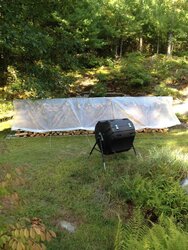
The third has been named the Display Case.
Again using what I have on-hand I decided to build something a little better contained and controlled.
I already see I could be deeper to allow for an area of absorbing material to build up more heat.
The unit is running close to 100F, but will not break that number.
I was hoping it would, so I could fan force air through it and maintain a strong temp.
Back is now closed on this unit and the top glass has been lifted for venting by 1/4".
So far, this is the only unit showing splits and cracks in the wood.
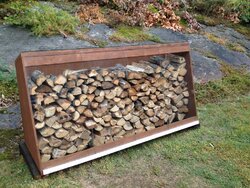
All wood has MC measured, but I don't feel this is best.. I'll also take opinions on this.
Specific pieces in the Display Case have been weighed (thought of this too late..) to better read the loss.
I've shown mine!
I'm open for suggestions!
Show me yours and tell me how and why.
I've been researching methods of expediting the drying process and found a few interesting ideas/ processes.
I also see it's bee talked about before here, but I don't see any listed results.
So, if you have done something on these lines, I'd love to hear what you've done and how well (or not) it worked.
I have 3 experiments running in the yard (ya, I'm serious about expediting drying) right now to see what works or doesn't.
The readings I will state are at full sun and ambient temp in the mid 60'sF
First is the 'Big Black Box'.
I took an old set of pipe staging and an old ladder (for shelves) and created a black plastic box.
The wood is stacked front and rear full, with the middle being open for air movement.
The ends of the middle was also stacked to create what I hoped to be a chimney.
Using 2 of my little solar panels and a computer fan, I set that up in the center to move air.
Since there is no vent at the top, I felt the fan is a must.
I have since added a second sheet of clear plastic, slopped off the unit to create more heat.
Unit reaches 98F in full sun inside.



Second is the least expensive for 'anyone' to do and has been named the S&G Stack.
I thought.. Why not..
This is based on the lean-to cover.
I have since closed the front to the ground and about to close the ends & and add a piece of black plastic on the ground in front of the pile (under the clear) to build more heat.
I'm open in the back by 1/4 of the stack height and will probably keep it that way.
I can read low 90'sF along the face and 130'sF along the top.
This surprised me!

The third has been named the Display Case.
Again using what I have on-hand I decided to build something a little better contained and controlled.
I already see I could be deeper to allow for an area of absorbing material to build up more heat.
The unit is running close to 100F, but will not break that number.
I was hoping it would, so I could fan force air through it and maintain a strong temp.
Back is now closed on this unit and the top glass has been lifted for venting by 1/4".
So far, this is the only unit showing splits and cracks in the wood.

All wood has MC measured, but I don't feel this is best.. I'll also take opinions on this.
Specific pieces in the Display Case have been weighed (thought of this too late..) to better read the loss.
I've shown mine!
I'm open for suggestions!
Show me yours and tell me how and why.




